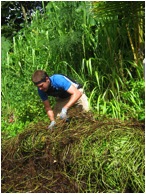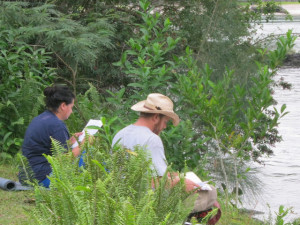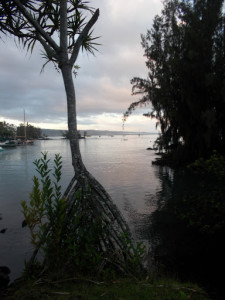By Mac MacLaird, Horticultural Supervisor Reeds Bay
When the Young Adult program moved to Reeds Bay, Hilo, the transition was similar to the transition plants go through when they get transplanted. For plants, the first couple days are the hardest, the first couple months at Reeds Bay were the most difficult for us. We had to adjust and redesign the program to fit into a residential facility. Programmatic difficulties aside, the land offered many challenges as well. Since our arrival at Reeds Bay we have been in the process of reclaiming the land from the jungle. It has been a beautiful struggle–a sweaty, creative process.
 Alongside the facility, there is a piece of land with a couple of brackish ponds. The ponds are fed by fresh water springs that flow out into the bay. The overgrown piece of land surrounding the ponds was called the Village, not because it looked like a village, but because one day it would be a Village. It was intense–the cane grass was twelve feet tall, the trees and bushes were over grown and out of control. Students and staff were intimidated by it and it was overwhelming. We had to clear it all before we could even start planting and using the land. The students called it the “malaria area,” because of the excessive mosquitoes and the itchy rashes caused by the cane grass. Every other day we had a work party with all the students working together to clear it. We worked in the blazing sun of the summer, sweating through the long sleeves and pants that we wore protect ourselves from the cane grass. We used hand picks, sickles and shovels to pull, remove and carpet roll the think layer of vines and weeds covering the ground. We all hated it, but loved to see the impact we made with each work party. The sense of hard work and accomplishment the students gained from this process was amazing. Students who started off as protesters became invested, diligent workers as they began to see the tremendous difference they made on the landscape. With the removal of the weeds, the mosquito population went down and the Village became a more hospitable place.
Alongside the facility, there is a piece of land with a couple of brackish ponds. The ponds are fed by fresh water springs that flow out into the bay. The overgrown piece of land surrounding the ponds was called the Village, not because it looked like a village, but because one day it would be a Village. It was intense–the cane grass was twelve feet tall, the trees and bushes were over grown and out of control. Students and staff were intimidated by it and it was overwhelming. We had to clear it all before we could even start planting and using the land. The students called it the “malaria area,” because of the excessive mosquitoes and the itchy rashes caused by the cane grass. Every other day we had a work party with all the students working together to clear it. We worked in the blazing sun of the summer, sweating through the long sleeves and pants that we wore protect ourselves from the cane grass. We used hand picks, sickles and shovels to pull, remove and carpet roll the think layer of vines and weeds covering the ground. We all hated it, but loved to see the impact we made with each work party. The sense of hard work and accomplishment the students gained from this process was amazing. Students who started off as protesters became invested, diligent workers as they began to see the tremendous difference they made on the landscape. With the removal of the weeds, the mosquito population went down and the Village became a more hospitable place.
The next step was visualization, planning and designing the landscape with the bigger picture in mind. Using laminated maps and dry erase markers I started sketching and brainstorming designs with staff and students. We had environmental factors to consider and accommodate; tides and the salinity of the soil. The occasional super high tide dictated how far we had to plant away from the water and the salinity of the soil determined the types of plants we could cultivate in the area. We decided to make the village a canoe plant garden, a) because they are hardy plants and can tolerate salinity and b) for their educational/ cultural significance. Canoe plants are the 22-28 different plants the original Hawaiian settlers brought with them on their voyage to Hawaii. They were selected for a plethora of culinary, medicinal, utilitarian and cultural purposes; they range from rhizomes like taro and bananas to trees like kukui and hau, all of which are currently growing in the Village. With this in mind, the work we are accomplishing in the Village is historical restoration work. We are creating a miniature, traditional Hawaiian garden. The ponds are a significant part of this historical restoration, they are fishponds. Fish ponds were used to catch and cultivate fish. We are fortunate to have this archaeological feature on our landscape and eventually we hope to utilize it and raise fish in the same way.
We started to create the first beds and paths in alignment with the contours of the pond. Taro was traditionally grown alongside fishponds, so that was the first crop we introduced to the Village when we started making beds. Taro is the most iconic canoe plant, it is a staple of the Hawaiian diet. Fish and poi, a starchy paste made from taro  roots formed the core of the Hawaiian diet. Digging in the rocky soil has given me a lot of respect for the original settlers who had to discover how to grow food in a land that lacks soil. As the beds were planted and the paths were placed the Village started to take shape. When the hales were introduced, the Village became a Kuleana camp. Around that time I became the Horticultural Supervisor and was able to fully commit my energy to the development of the land. Progress picked up and every day brought change to the Village. The students and staff participating in this process became more invested as they realized that their contributions would live on in the legacy of the land. We are lucky to have passionate staff contributing and bringing their special talents to the Village. Anyone who spends enough time out there eventually leaves a mark. The feeling of legacy is contagious and we are all a part of it, laying a foundation and growing food to benefit future generations of students. Making a measurable difference on the land is one of the many milestones for Kuleana students. The students who have gone through Kuleana in the Village are coming out of it with improved work ethic and increased investment in the program. I
roots formed the core of the Hawaiian diet. Digging in the rocky soil has given me a lot of respect for the original settlers who had to discover how to grow food in a land that lacks soil. As the beds were planted and the paths were placed the Village started to take shape. When the hales were introduced, the Village became a Kuleana camp. Around that time I became the Horticultural Supervisor and was able to fully commit my energy to the development of the land. Progress picked up and every day brought change to the Village. The students and staff participating in this process became more invested as they realized that their contributions would live on in the legacy of the land. We are lucky to have passionate staff contributing and bringing their special talents to the Village. Anyone who spends enough time out there eventually leaves a mark. The feeling of legacy is contagious and we are all a part of it, laying a foundation and growing food to benefit future generations of students. Making a measurable difference on the land is one of the many milestones for Kuleana students. The students who have gone through Kuleana in the Village are coming out of it with improved work ethic and increased investment in the program. I  feel fortunate to have the opportunity to be a part of the formation of this camp, the dynamic landscape offers a lot of possibilities that we have never had before at Pacific Quest. We have the opportunity to cultivate fish, to grow wet land taro, and create a traditional Hawaiian garden.
feel fortunate to have the opportunity to be a part of the formation of this camp, the dynamic landscape offers a lot of possibilities that we have never had before at Pacific Quest. We have the opportunity to cultivate fish, to grow wet land taro, and create a traditional Hawaiian garden.
This story, the story of the land, is an important part of the Young Adult program. It’s a story about change and making a difference. The land was over grown and wild until we started cultivating it, caring for it and taking responsibility for it. It has changed and it is growing; this process not only parallels the process of growth the students are going through, but the development of our program as well, the difficulties we faced in the transition from Ka’u to Reeds Bay and the challenge to redefine the program in this new setting. The change in the landscape is visible, measurable evidence of the positive change that the program and the students are going through. Now that the stress and shock of transplant is wearing off, Pacific Quest is truly beginning to grow and thrive in Reeds Bay.